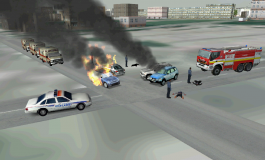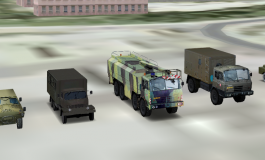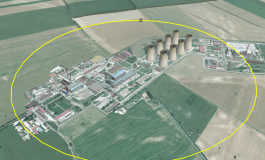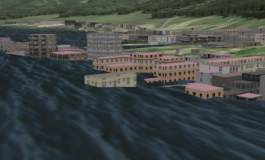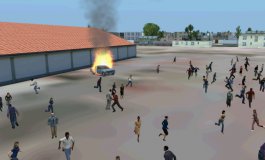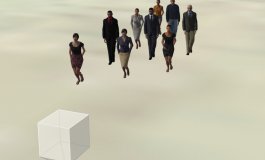SIM
Simulation utilisation
Simulation technology is one of our most prominent areas of expertise, emergency management support and other activities regarding these areas. We offer various types of simulation for better managing of emergency and other situations. There is much long-year experience employed when supporting CAX-type military exercise, including newest knowledge and technologies in process, but also new digital terrain preparation and expanding simulations systems capabilities.
Developing application equipment is integral part of our portfolio. Our company focuses itself at expanding functionality of constructive simulation system. There is separate simulation system to process incidents handled by emergency management.
Crisis Management
Crisis management module for constructive simulation system is designed for simulating emergency situations to train staff of crisis management.
Simulation environment:
- provides a complex view of the simulation in real time
- allows to simulate a huge amount of objects and activities
- allows to create, run and distribute a variety of simulation scenarios
- allows both 2D and 3D view of the simulation
- supports multiple formats of terrain databases
- allows to distribute information to all computers in simulation environment about entities and activities
Crisis management module focuses on the following areas:
- the individual‘s behaviour in the crowd, and the person‘s movement in the built-up area
- leak of hazardous substances – chemical contamination
- leak of radioactive substances – radioactive radiation
- flooding
- evacuation
- traffic accident and treatment of injured
Each area includes a newly created entities and tasks to simulate activities and events related to crisis management.
The crowd behaviour allows you to simulate:
- The individual‘s behaviour in the crowd (random movement of groups, movement of groups along specified route, to specified location or checkpoint).
- Various forms of aggressive crowd behaviour such as demonstration, setting up fires, building barricades, destroying vehicles, attack on another crowd, individual, armed forces or vehicles.
- Mass evacuation, with an option to generate a large number of simulated persons and define impossible doors and areas within the building, i.e. spaces can be used for evacuation.
Chemical contamination allows you to simulate:
- Static contamination of area by toxic or hazardous substances, for example: Tabun, Sarin, Chlorine or Hydrogen cyanide.
- The spread of air contamination depending on the weather.
- Entity contamination after entry into the contaminated area, measure level of contamination using specific sensors.
- Creation of decontamination areas, such as: tents for person decontamination and decontamination of vehicle by hot air or by chemical substance.
- Decontamination of contaminated entities.
- Dismantling decontamination areas.
Radioactive radiation allows you to simulate:
- Leaking and spreading of radioactive substances causing radiation Alpha, Beta or Gamma type with specified level of radiation, measurement of the radiation‘s intensity with sensors.
- Impact of the radiation on living organism.
Flooding allows you to simulate:
- Spreading from a source and its impact on the persons and vehicles.
- Allows evacuation of people from the flooded areas.
Traffic accident and treatment of injured allows you to simulate:
- Car accident and injury of the crew.
- Giving first aid / treating of injured person by doctor.
- Transportation of injured person by ambulance.
The system offers the possibility of simulation to providing medical aid, according to the nature of an existing injury. It is possible to set up type of injuries, such as fracture, burn injury, incised wound and more.
Crowd Behaviour Module
Crowd Behaviour Module is a module for constructive simulation, which supports the simulation of crowd behaviour. It extends the functionality of a common simulation environment VR-Forces 4.3 in modelling and simulation issues for crisis management features with a focus on the behaviour of individuals as well as behaviour of crowd in the built up area.
Simulation environment provides a complex and realistic view of the simulated situation in a real time with plenty of simulated objects and phenomena. Aggregation of individuals into more complex entities is also part of the crowd behaviour module. It is easy to switch between viewing modes or to open a secondary window and use a different regimes in each of them. In any view, you can quickly navigate through the terrain.
Simulation tool supports multiple formats of terrain databases. For the purpose of simulation of entities movement inside of buildings you can use number of predefined buildings with interior (UHRB – Ultra High Resolution Building - definition file), or you can create your own buildings with interior by using third party software.
Simulation tool allows you to create, run and distribute a variety of simulation scenarios. It is possible to create both 2D and 3D view within the simulation environment. You can track the progress of the simulation from the perspective of a simulated entity by using 3D view or you can choose an independent point of view.
The Crowd Behaviour Module is structured into the following tasks:
- building evacuation
- random crowd movement
- crowd movement
- aggressive crowd behaviour
Building Evacuation
Building Evacuation Module allows to automatically generate/create large number of simulated entities within the selected building.It simulates mass evacuation of a building. By using various obstacles inside of the building you can verify the possibility of evacuation routes and time schedules.
Random crowd Movement and Crowd Movement
The Crowd Movement allows to simulate random crowd motion, movement along the desired route, movement to the point or movement to the certain checkpoint. Random crowd motion task is focused on groups of civilians and rioters. You can set up an area, where the crowd should move at random.
Movement to the certain point or checkpoint tasks are assigned for individuals and groups, where user selects the certain location from the map or the point, where he wants to move the entity. Task accepts different types of soil and sidewalk preference. Movement along the specified route task is assigned to entities, where user needs to choose a route that should be used by entities.
Aggressive Crowd Behaviour
The Aggressive Crowd Behaviour is simulated depending on the presence of incentives for aggressive behaviour. Presence of military units, civilians with another jurisdiction and civilian vehicles in the vicinity of the crowd are among the incentives for aggressive behaviour. Based on the environment conditions and parameters of the task, aggressive behaviour is manifested by a random implementation of aggressive actions such as:
- attack on the military unit
- attack on civilians of another jurisdiction
- attack on civilian vehicles
- vehicles destruction
- setting fire
- creation of barricades
Control Tower Simulator
The Control Tower Simulator is the simulation system used for airport operations simulation.
- Contains functionality to simulate and visualize air traffic control.
- Allows you to make airport control tower staff training more realistic.
- Provides a complex, realistic view on simulated situation in a real time.
- Allows you to create, run and distribute a variety of simulation scenarios.
- Allows both 2D and 3D view of simulated activities and objects.
- Includes terrains with runways.
- Allows addition of new terrain databases.
Includes a large number of simulated entities and objects, such as:
- Airborne entities: civilian aircrafts, helicopters, fighter planes
- Airport ground vehicles: towing vehicles, transport vehicles, ambulance, police cars, fire trucks
- Infantry entities – civilian, military ground units
- Animals: birds, others
Tasks implemented for airport ground and air simulation:
- air units control tasks
- airport lighting tasks
- ground vehicles tasks: aircraft towing, accompanying vehicle etc.
- accidental collisions with birds and other animals
Tasks to control air entities:
- taxing - move around the airport
- flight to a point or following a route
- landing
- take – off
- pulling by vehicle
- pushing by vehicle
- aircraft lights control and smoke or fire display
Tasks for land-based entities control:
- vehicle lights and beacon control
- connecting vehicles to the aircraft
- follow me car tasks
- pushing and pulling the aircraft
Airport lighting control allows to set:
- individual runways lights
- approach lights for both directions independently
- stand lights
Accidental collisions of aircrafts and birds
For realistic representation of the overall situation at the airport and air traffic, there is possibility to simulate accidental collisions with birds and other animals including simulation of reactions of birds to countermeasures.
Expandability and usability environment simulation:
In addition to the activities related to standard air traffic simulation it is possible to simulate other situations:
- fire fighting module
- chemical substances leakage, spread of chemical contamination and measures related to these situations
- radioactive substances leakage
- airport flooding
- traffic accidents
- random crowd movement
Fire
Fire Module for constructive simulation system is designed to simulate wildfire behaviours – fire spreading, firefighting and damage to entities exposed to fire.
Simulation environment:
- Provides a complex view of the simulation in real time
- Terrain with separate layer for fuel model
Fire Module provides following functionalities:
Fire spreading:
- several fire sources in open space
- dependent on weather condition
- impact on simulated lifeforms and vehicles
Firefighting:
- different methods of extinguishing
- variety of extinguishing substances
- monitoring of extinguishing substances consumption and refilling
To simulate the spreading and extinguishing of fire it is necessary to have a terrain with separate layer for fuel model and appropriate tasks:
- Fire spreading
- Firefighting (fireman with nozzle, fireman with fire bag, firefighter truck with nozzle or aerial forest fire fighting)
- Water resupply
Fire spreading task simulates:
- Terrain topography and fuel model used
- Weather Conditions (precipitation, wind speed and direction)
- Ongoing extinguishing operations
Fire spreading consists of these states - ignition, burning and burnout area. Each area with one of these states represents a part of the affected zone.
Firefighting task simulates:
- Firefighter with nozzle - effectiveness depends on types of nozzles and pipes, pressure of pump, length of pipe and terrain elevation
- Firefighter with fire bag manual pump
- Firefighter truck with nozzle
- Helicopter equipped with water bag of different volumes
Firefighting unit can affect the spread of fire by extinguishing, check quantities of extinguishing substance and refill water from natural sources or from other firefighting units.
Water resupply task simulates:
- Refilling water from natural sources
- Refilling water from other firefighting units
Refilling time from natural source or firefighting unit depends on the flow rate of the pipe and on the pressure of pump.
Evaluation module for calculating the impact of fire on the simulated entities:
Evaluation module is part of the Fire spreading task.The impact of fire on entity depends on the entity type and its distance from fire. All affected lifeform entities are damaged. Firefighters and some vehicles are not damaged by fire, if they are moving or they are flying in the air at a certain height.
